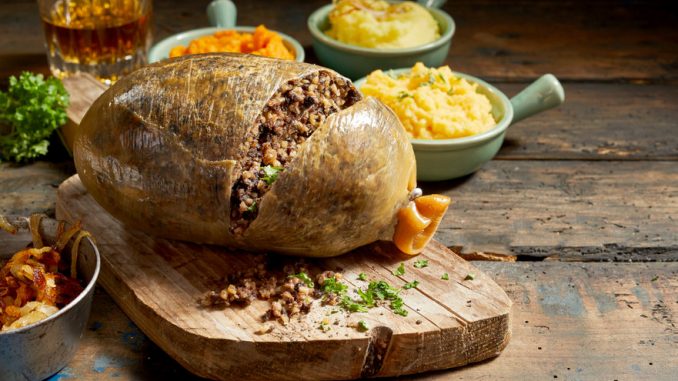
Haggis is a savoury pudding that originally came from Scotland. Indeed, the best haggis is to be found there and is a mix of minced sheep’s heart, liver and lungs, with onion, oatmeal, suet, spices and salt. It is encased nowadays in an artificial casing rather than the original stomach lining of a sheep or cow.
The original haggis type foods probably originated elsewhere when all the animal was used. Greece and ancient Mesopotamia have always been likely candidates because excavations have revealed minced offal in a variety of linings from animals used as natural casing to protect the food during cooking.
Cooking
Most bought haggis is cooked already so when it comes home it just needs to be warmed up. I prefer to fry rounds of haggis with a small amount of oil simply to ensure it is is piping hot. It has an annoying tendency to break up during this process but I know then that it’s cooked through.
OK – frying. There are myriad ways of cooking it and serving it up. The traditional method is with mashed parsnips, swede and potatoes. Sadly it seems to be a food eaten by tourists and whenever I’m in Scotland I feel I know I’m feeding that myth when I order it. However, it is available south of the border and much more popular than you think. In Coleford you have to order it as it will be old out before Burns Night when it has usually been traditionally scoffed. One serving suggestion is to fry a poached egg and layer it on top. the egg serves as a sauce. My other favored approach is to have it with a herby sausage, bacon and mushrooms. This is sacrilege I know but there is no point wasting writing space on the merits of this when flavour is what is being sought.
Cooking Haggis in the Microwave Oven
Simply remove the skin/casing, slice, and place into a microwave safe bowl.
Add a small amount of water, cover and microwave on full power for three and a half minutes. Stir or move the haggis after a couple of minutes. When ready, remove, stir, cover, and allow to stand for one to two minutes before serving.
Cooking Haggis in the Oven
Wrap the haggis gently in aluminium foil and carefully place in a lidded casserole dish with a little hot water. Place in a heated oven at 180ºC – 190ºC for one hour for a 500g haggis. Increase the time by 10 minutes for each extra 200g. Add more water if necessary. However, do not allow to dry out.
Cooking In Water
Wrap the haggis in aluminium foil. Place in a large saucepan of cold water. Bring to the boil and just simmer ever so slightly to avoid bursting the casing. It’s very easy to do. It doesn’t spoil it but you could lose some of that delicious fat.
Cook the haggis for one hour for every 500g of haggis. It seems quite long but gives very good results. For every 200g extra, increase cooking time by 10 minutes.
Preparing Haggis
Ingredients
For the Haggis:
- 1 sheep’s stomach
- 1 sheep’s pluck (heart, liver, and lungs)
- 450 grams beef or lamb suet
- 2 large onions, finely chopped
- 225 grams oatmeal (toasted)
- 1 teaspoon ground black pepper
- 1 teaspoon ground white pepper
- 1 teaspoon ground nutmeg
- 1 teaspoon ground coriander
- 1 teaspoon salt
- 1/2 teaspoon cayenne pepper
- 250 ml beef stock
Preparation
1. Prepare the Sheep’s Stomach:
- Rinse the sheep’s stomach thoroughly under cold water.
- Soak the stomach in cold salted water for several hours or overnight, then rinse again.
2. Prepare the Sheep’s Pluck:
- Rinse the heart, liver, and lungs under cold water.
- Place the pluck in a large pot of cold water. Bring to a boil, then reduce the heat and simmer for about 2 hours, skimming any scum that rises to the surface.
- Remove the pluck from the pot and let it cool. Reserve the cooking liquid (stock).
3. Toast the Oatmeal:
- Preheat your oven to 180°C (350°F).
- Spread the oatmeal on a baking sheet and toast in the oven for about 10-15 minutes, or until lightly browned. Stir occasionally to ensure even toasting.
4. Prepare the Filling:
- Finely chop or mince the cooked heart, liver, and lungs.
- In a large mixing bowl, combine the minced pluck, toasted oatmeal, finely chopped onions, suet, black pepper, white pepper, nutmeg, coriander, salt, and cayenne pepper.
- Gradually add the reserved cooking liquid (beef stock) to the mixture, stirring well until everything is thoroughly combined. The mixture should be moist but not too wet.
5. Stuff the Stomach:
- Spoon the filling mixture into the prepared sheep’s stomach, pressing it down to eliminate any air pockets. Fill the stomach just over halfway to allow room for expansion.
- Sew the opening of the stomach closed with kitchen twine or a sturdy needle and thread.
6. Cook the Haggis:
- Place the stuffed stomach in a large pot of boiling water. Make sure there is enough water to cover the haggis completely.
- Reduce the heat to a simmer and cook gently for about 3 hours. Ensure the water does not boil vigorously, as this may cause the stomach to burst.
- Check the haggis occasionally and add more water if necessary to keep it submerged.
7. Serve:
- Carefully remove the haggis from the pot and let it rest for a few minutes.
- Place the haggis on a serving platter. Traditionally, haggis is served by cutting a large slit in the stomach to reveal the filling.
- Serve the haggis with neeps (mashed turnips) and tatties (mashed potatoes).
Note: Preparing and cooking haggis can be an involved process, and finding a sheep’s stomach and pluck might be challenging depending on your location. Some modern recipes substitute the sheep’s stomach with sausage casing or use pre-prepared haggis available from specialty butchers or online sources.
Recipe: Sriracha Haggis Cheese Toastie
Ingredients:
- 2 tbsp. olive oil
- 2 cloves of garlic, minced
- 250g traditional or vegetarian haggis – crumbled.
- 1-2 tbsp. Sriracha sauce
- 2 tbsp water
- 100g cavolo nero kale, chopped
- salt to taste
- chilli flakes to taste
- 8 slices of brown bread
- 4 tbsp. butter
- 1 mozzarella ball
- 100g cheddar cheese
Preparation:
- To a saucepan, heat a tablespoon of olive oil and fry the garlic for a couple of seconds, then add the haggis, sriracha sauce and water. Stir to combine and heat through for about 5 minutes. Reduce the heat.
- To the pan add the remaining olive oil, minced garlic, kale, chilli flakes and salt. Stir to combine, cover with a lid and cook on the lowest heat for approximately 10 minutes. Add some water if the kales starts to burn.
- To create the toastie, spread 1 tbsp. of butter on one side of the only of the two slices of bread, with a quarter of the Sriracha haggis mixture, kale and cheese. Lay the cheese toastie on a frying pan with the buttered side down.
- Toast on both sides in a frying pan until golden and the cheese is melted.

Leave a Reply